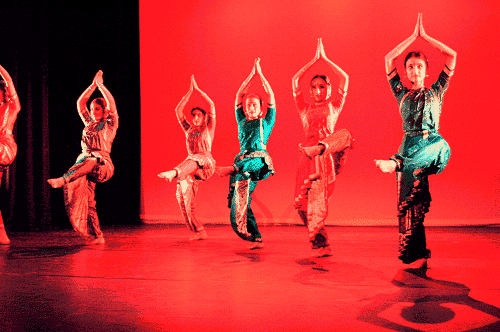S
& H Concert Review
Elgar,
Finzi, Holst, Indian Dance; Soloists, City
of Birmingham Symphony Orchestra/Simon Halsey,
Symphony Hall, Birmingham, 18th May,
2004, (CT)
Sarah Connolly – mezzo-soprano
Mark Padmore – tenor
James Rutherford – bass-baritone
City of Birmingham Symphony Youth Chorus
sampad – Piali Ray (choreographer)
Praveen Rao and Sanchita Pal (musicians)
Opportunities to hear Holst’s one act chamber opera, Savitri, are rare. To hear it performed in a semi-staged setting as here, accompanied by a combination of Indian dance and mime is an opportunity not to be missed and this was clearly not lost on the Birmingham audience who turned out in admirable numbers on a warm, early summer evening.
As an appetiser the evening opened with a brief South Indian classical dance, beautifully choreographed by Piali Ray and equally finely danced by members of sampad, the Birmingham based South Indian arts organisation founded by Ray in 1990. The musical accompaniment was possibly just a little over amplified but the overall impact was such that I suspect more than a few members of the audience were unexpectedly won over by the experience.
It was unfortunate that following the dance, for which suitably subtle and highly effective lighting was used, the Symphony Hall staff chose not to raise the house lights, this despite the fact that the stage was being reset for the music to follow. As a result it was plain to see people trying to read their programmes in vain, unable to familiarise themselves with what was to come. The same problem occurred in the second half when similar lighting was employed in Savitri, meaning that printing the libretto in the programme for those who wanted to follow it was something of a waste of time. The lighting over the audience could easily have been raised just slightly to alleviate this problem without distracting from the events on the stage.
When the lights were eventually raised following the dance, the strings of the CBSO gave a touching performance of Elgar’s Serenade for Strings, played with affection and a wonderful warmth of tone that put the string sections of certain recent visiting orchestras to shame. I would have liked Simon Halsey to caress the characteristic slow movement a little more but the charm and delicacy of the playing was such that any such concerns were quickly dispelled. If there was a nagging doubt it had more to do with the order of the programme, with the Elgar sitting rather oddly after the Indian dance. To my mind it would have been a more sensible option to open the second half with the dance, which would have provided an excellent precursor to Savitri.
Mark Padmore’s performance of Gerald Finzi’s glorious Dies Natalis that closed the first half was wonderfully lucid and marked by a clear headed and natural response to the composer’s moving homage to the innocence of childhood. There was just the occasional moment when Padmore seemed to be straining against the CBSO strings but the pristine clarity of his diction was equalled by the sensitivity of the players.
Just one song, The Travellers, from the third set of Holst’s Choral Hymns from the Rig Veda opened the second half (what a great shame that time could not be found for the complete set) in a spirited performance by the girls of the City of Birmingham Youth Chorus under the direction of Shirley Court. Brief though it was, it provided a useful introduction to Savitri, the performance of which turned out to be the highlight of the evening.
Best described as semi-staged, the orchestra were seated in the pit along with the offstage choir. For their part, the three singers were spotlighted in their positions to the side of the stage whilst the dancers of sampad took centre stage, beautifully presented in traditional dress. The blend of dance and mime, as with the dancing at the beginning of the concert, was skilfully choreographed with the singers effectively providing a commentary on the action. It was perhaps a shame that the lights were once again dimmed to the point that the programme printed libretto could not be read, yet the action on the stage was such that the eyes were constantly drawn to the performers. The overall result was a magical experience, sung impeccably by Mark Padmore and Sarah Connolly in the principal roles of Satyavan and Savitri, with bass-baritone James Rutherford equally impressive as the voice of death, Satyavan’s tormentor and ultimate saviour thanks to Savitri. Indeed, this was one of those all too rare performances that left an immediate desire to experience it again.
In conclusion, a fitting finale to an unusual and memorable concert for which congratulations were due to all concerned.
Christopher Thomas

 Return to:
Return to: